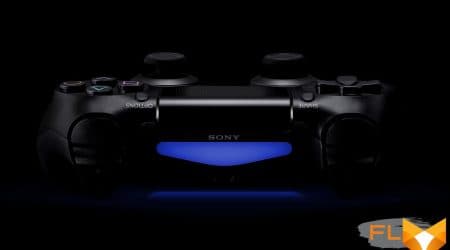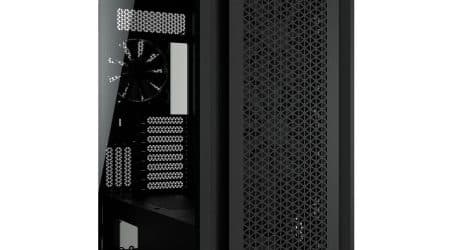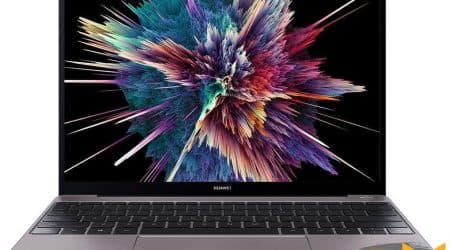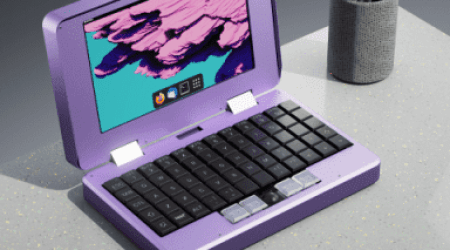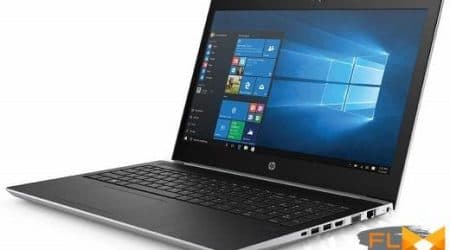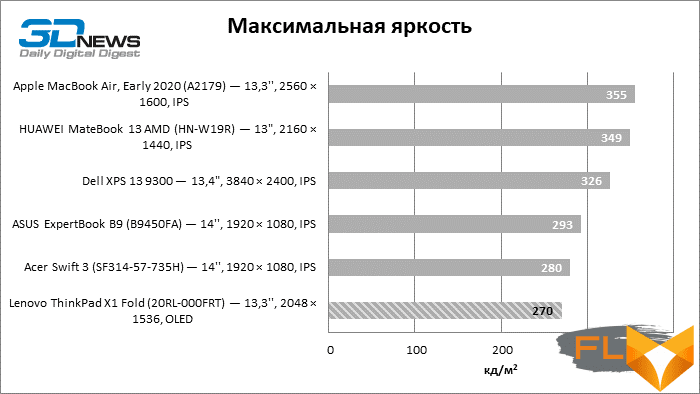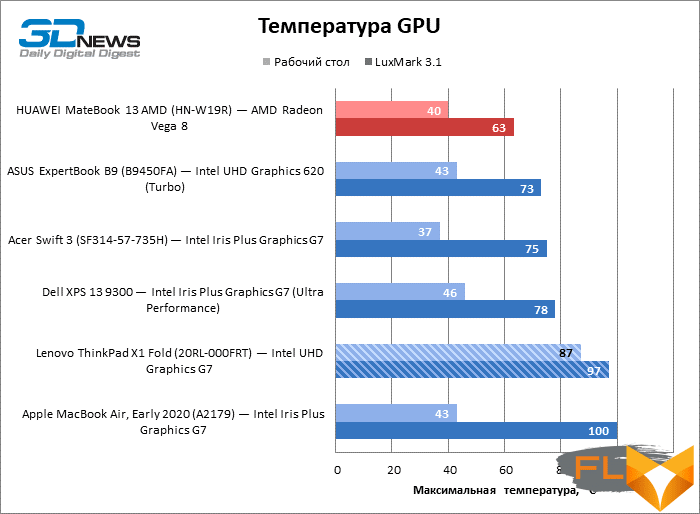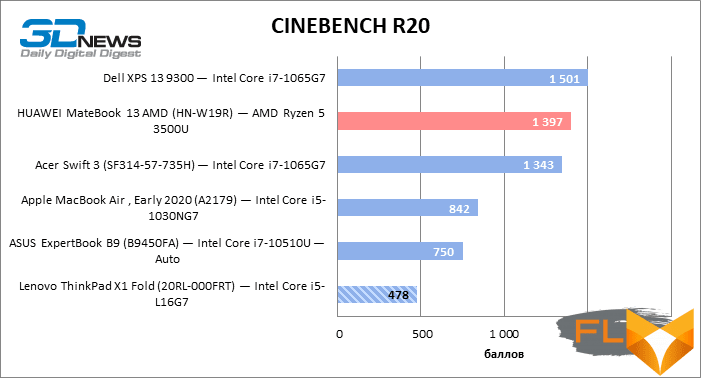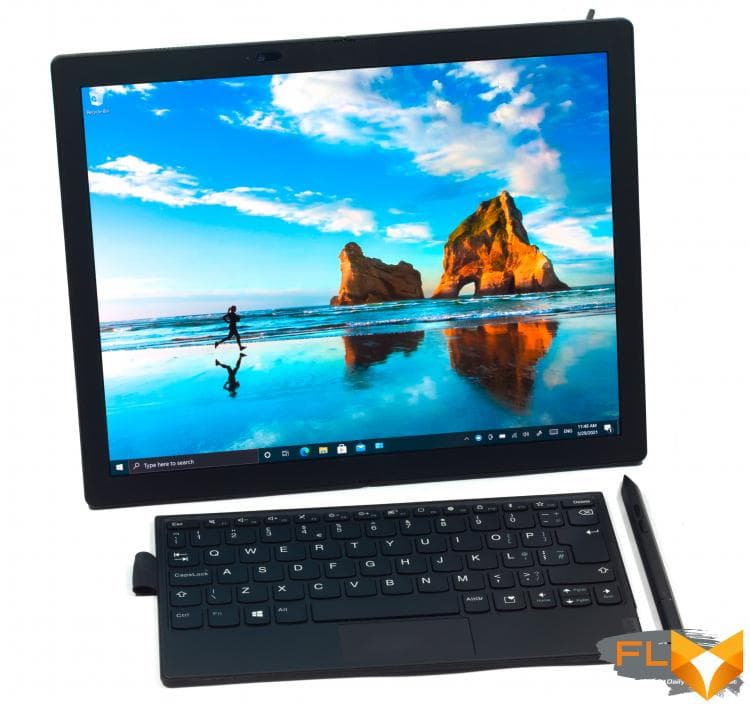


The Lenovo ThinkPad X1 Fold first showed up at CES in January 2020, but it took almost a full year before the device was ready for mass production. The fact is that this is not an ordinary convertible laptop (or, if you like, a tablet), but a transformer of a completely new design, built around a flexible OLED panel. All in the name of maximizing screen real estate and at the same time making the computer incredibly compact when folded. But a flexible screen wasn’t all it took to make Lenovo’s vision a reality. We had to wait for Intel to mass-produce the Lakefield system-on-a-chip with a 3D multi-chip layout that also embodies the first asymmetric architecture with x86 instruction set, using CPU cores of different power for different functions.
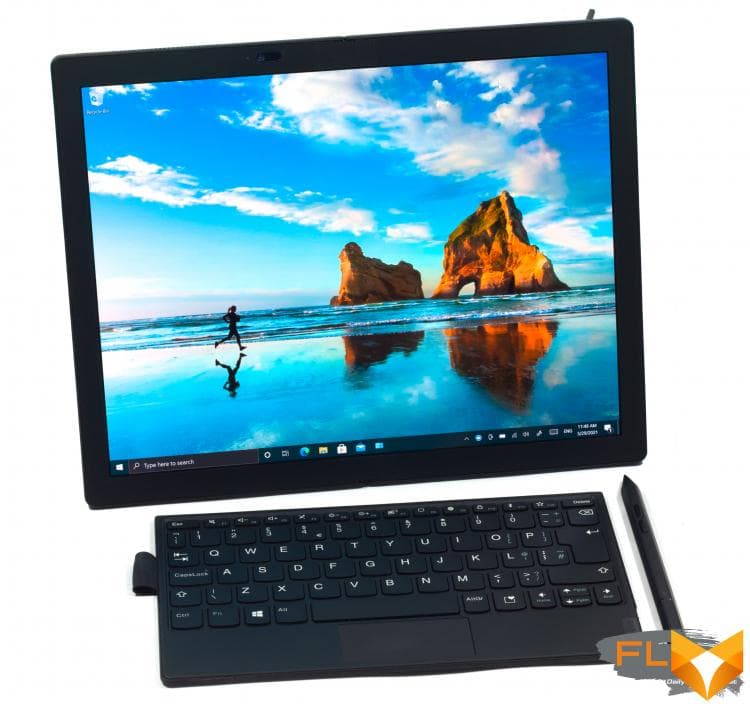
The Lenovo ThinkPad X1 Fold brings together several cutting-edge technologies to give you the best that a laptop and tablet can offer individually. Indeed, Lenovo turned out to be an extremely curious and unique product, but, as often happens in such cases, it was not possible to jump into the future without stumbling. The ThinkPad X1 Fold is plagued by a plethora of compromises, both in terms of form factor and still imperfect Intel hardware.
⇡#Specifications, prices
Lenovo engineers were faced with the challenge of fitting the contents of a computer into an extremely limited space. So, I had to use specific hardware, and not so long ago, the idea of the ThinkPad X1 Fold was simply impossible to put into practice. Laptops or 2-in-1s that are thinner than the ultrabook we’re used to are no longer a novelty, but they’re not exactly suitable for ordinary mobile processors, even if we are talking about the most energy-efficient varieties of silicon from Intel and AMD. After all, difficulties are created not only by the requirements for cooling and powering chips with adequate performance for desktop tasks, but also by the complexity of the motherboard layout and, surprisingly, the thickness of the PCB sandwich, system-on-a-chip and heat sink. For the combination of these reasons, for the production of the thinnest and lightest machines, they prefer to use specialized ARM SoC architectures – for example, Qualcomm chips that grew out of smartphones. Another example is Apple’s A-series silicon in today’s iPads, which are getting closer in functionality to classic laptops every year.
However, it is not difficult to guess why such devices are still difficult to call full-fledged computers for any task. Most users are not ready to abandon the entire software library written for Windows (or macOS, Linux – substitute what you need) for the x86 instruction set, and the ecosystem of the ARM version of the Microsoft OS is still in its infancy. You can talk for a long time about the prospects of ARM and the “moral obsolescence” of x86, but the company most interested in the future of this ISA – Intel – does not leave attempts to spread it to the area of ultra-low power consumption and the most limited dimensions. We are talking about the Lakefield system-on-a-chip, which is far from the first initiative of this kind on the part of Intel (just remember netbooks, and then smartphones on Atom processors), but the main thing is how Lakefield processors differ from their not-so-successful predecessors, is an integrated approach to the problem, which eventually led to the creation of a device such as the Lenovo ThinkPad X1 Fold.
Instead of endlessly scaling high-performance Core logic towards lower power consumption or, conversely, pushing Atom cores, which are not far behind the Pentium III in complexity, Intel has made a turn towards a heterogeneous architecture. Lakefield is the first x86 asymmetric processor to feature four economical Tremont cores and one fast Sunny Cove core. The latest hybrid CPU was borrowed from the widespread Ice Lake mobile chips, but Tremont, what can you do, is the next iteration of the Atom core (by the way, the first in three whole years).
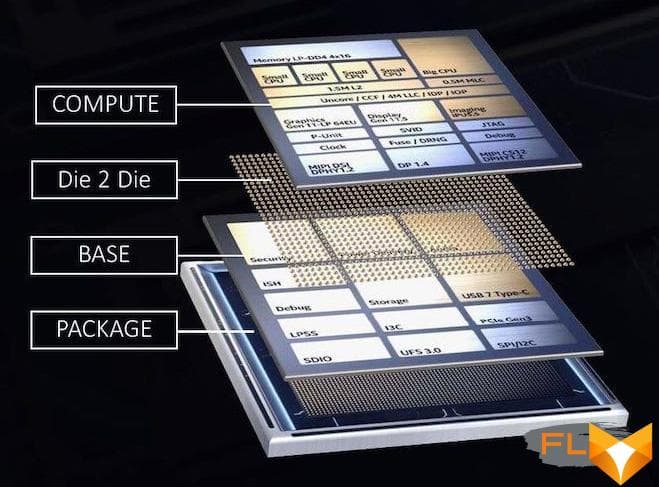
Does all this mean that thanks to Lakefield chips, ISA x86 will finally find solid ground under its feet in the area from which it has been shamefully expelled more than once? After all, asymmetric CPUs have proven their unconditional efficiency under the most stringent requirements for power consumption and heat dissipation. It seems impossible to imagine a competitive SoC of another architecture for a smartphone, tablet, or, as in the case of the ThinkPad X1 Fold, an ultra-compact two-in-one computer. But the formula of Lakefield cores is fundamentally different from the prevailing design of ARM’s SoCs in that it contains only one large high-performance core. The fact is that the Sunny Cove logic was transferred to Lakefield silicon with minimal changes, including a large integrated GPU, and at least the second such core is already beyond the performance limits that Intel was oriented towards. As a result, the bulk of the computational load in Lakefield again falls on the Atom cores, and the only powerful Sunny Cove core is supposed to be used only occasionally for functions that are sensitive to delays that could negatively affect the user experience (for example, working out touching the screen or typing on the keyboard). ), – the Windows scheduler will take care of this distribution of tasks. Thus, Lakefield silicon, like most innovative solutions that go against the old order, is bound by the compromises of the transition period and is unable to claim a level of performance that is in any way comparable to what we used to expect from modern laptop CPUs.
Be that as it may, there are simply no other options, with the exception of Intel Lakefield, if one of the determining factors in a computer device is not only power consumption, but also the volume of components. Lakefield is a full-featured system-on-a-chip, distributed over two chips – the actual hybrid CPU with integrated graphics, manufactured according to the 10 nm standard, and a 22-nm chipset with all external interface controllers. The crystals are located one on top of the other and are connected directly without an interposer using Foveros proprietary technology, due to which it was possible to minimize the area occupied by a microcircuit on a printed circuit board. A RAM chip was added on top (Intel offers Lakefield variants with 4 or 8 GB of LPDDR4X RAM), but the package height remained within 1 mm. And thanks to the deep integration into the SoC of the mass of support functions that otherwise require discrete logic, the motherboard contains a minimum of layers and takes up little space. It is thanks to these characteristics that it became possible to produce ultra-thin laptops or, as in the case of the Lenovo ThinkPad X1 Fold, transformers that have not lost support for conventional Windows operating systems.
| Manufacturer | Lenovo |
|---|---|
| Model | ThinkPad X1 Fold |
| Display | 13.3”, 2048 × 1536, OLED, touch |
| CPU | Intel Core i5-L16G7 (1+4 cores/threads, 1.4-3.0 GHz) |
| RAM | LPDDR4X SDRAM, 4266 MT/s, 8 GB (two channels) |
| GPU | Intel UHD Graphics G7 (system RAM) |
| Accumulator | NVMe (PCIe 3.0 x2) 256GB-1024GB |
| External I/O connectors | 2 × USB 3.2 Gen 2 Type-C (1 × DisplayPort) |
| Network | IEEE 802.11ax + Bluetooth 5.1;
LTE/5G (optional) |
| Battery capacity, Wh | 50 |
| Weight, kg | 1 |
| Overall dimensions (L × H × D), mm | 299 × 236 × 11.5 (158.2 × 236 × 27.8) |
| Retail price | From $5900 |
Intel introduced only two SoC Lakefield models – Core i3 and Core i5, which differ from each other in the clock speeds of the CPU cores and the set of active blocks of the integrated GPU, but are characterized by the same TDP – 7W. The ThinkPad X1 Fold got the flagship chip, complete with 8 GB of RAM, and the ROM is a (removable, but very hard to access) SSD from 256 GB to 1 TB. And since the ThinkPad X1 Fold can rightly be called both an ultrabook and a tablet, it is not surprising that in addition to the standard wired and wireless communication interfaces (USB 3.2 Gen 2, WiFi 6 and Bluetooth), it received an optional LTE / 5G modem.
But the unique feature of Lenovo’s product is, of course, the flexible OLED screen, which we will be paying close attention to very soon. In the meantime, we note that the main goal of the Intel project Lakefield is not at all consumer goods, which were netbooks that have long since left the scene, but premium devices. There are no cheap offerings among the few Lakefield chip-based pioneers, and the ThinkPad X1 Fold is clearly the most refined and unusual of them all. Therefore, it costs accordingly – at least $ 5,900. (for a complete set with a keyboard and stylus as of the date of preparation of the review). At such a cost, we consider the novelty to be evaluated in practical terms as a deliberately failed task. If Lakefield was Intel’s first, and by all indications experimental, embodiment of long overdue ideas, then the ThinkPad X1 Fold with its flexible screen is an experiment squared.
⇡#Look and Ergonomics
It is difficult to say what type of device the ThinkPad X1 Fold is in the first place – a tablet or a laptop, but if you focus on the minimum configuration of the novelty without a keyboard, then this is still a tablet. Not the thinnest among its kind (11.5 mm), and not the lightest (about 1 kg), but with a huge screen – 13.3 inches. This is an OLED matrix with a rare but still convenient 4:3 aspect ratio and a resolution of 2048 × 1536.
And best of all, no other tablet can be picked up and folded in half like the ThinkPad X1 Fold. It is in tablet mode that this feature is hardly particularly useful (except for reading in the same way as a paper book or magazine), but the folded ThinkPad X1 Fold takes up no more space than a plump diary. Actually, this is the point of Lenovo’s idea, and a flexible OLED matrix, unlike two separate screens, maintains a continuous workspace.
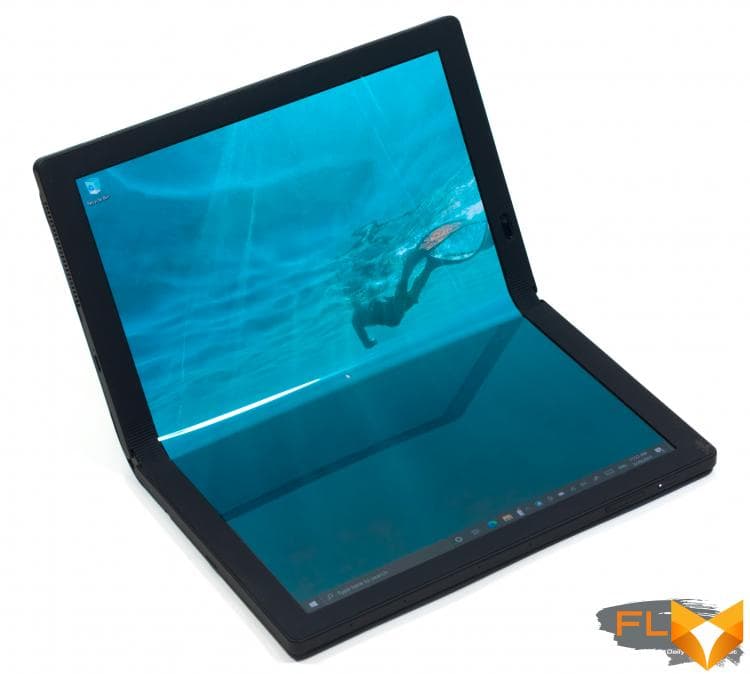
Mechanically, the foldable design of the ThinkPad X1 Fold is impeccable. The hinges are tight enough to hold any opening angle, the planes of the two halves of the body rotate without any distortions, and the joints are covered with elastic accordions. But aesthetically, the front surface of the device, of course, loses to the fixed laminated screen of an ordinary tablet. Regardless, the glossy film surrounded by wide rubberized bezels isn’t something you’d expect to see in a $5,300 computer. In addition, the screen of the ThinkPad X1 Fold instantly becomes covered with fingerprints, and it is more difficult to remove them from a soft surface than from glass. The durability of the hinges and, especially, the OLED matrix itself at the fold is an open question. Lenovo, of course, promises that the tablet can be folded and unfolded tens of thousands of times without any consequences (and the film, by the way, bends along a very small radius), but only time will tell when wrinkles appear on the screen. So far, only small waves are visible in the inflection zone, if you look at it from an acute angle, because here the film tension is the least.
When folded, the ThinkPad X1 Fold already looks like an expensive device, which it really is, because the reverse surface is tightened with natural leather that looks and feels nice. Lenovo does not offer an “eco-friendly” option with, for example, a silicone coating, and the case cannot be removed without damaging the adhesive tapes that hold it in place. The lid section leans back on hinges, turning into a prop.
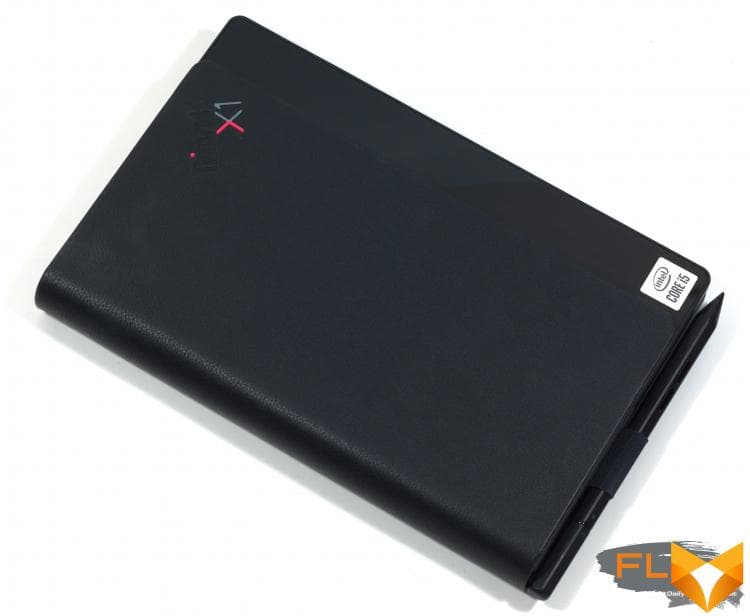
There is nothing like the ThinkPad X1 Fold among tablet computers yet, but this is not only a tablet, but also a full-featured laptop with the usual version of Windows, and if so, you need a physical keyboard and touchpad. In the maximum configuration of the computer, there is already a suitable size option. You can put it on the table separately from the tablet or cover half of the screen with the keyboard, which is what it is intended for in the first place. In any case, there is no electrical connection between the devices, the keyboard is connected via Bluetooth and is simply held in place by magnets. And when the laptop is closed, it fits perfectly into the space between the screen halves. Otherwise, there is a gaping gap, which makes the basic configuration of the ThinkPad X1 Fold without a keyboard look especially ridiculous.
It is not required to feed the wireless manipulator with a separate cable (it is charged from the inductor in the laptop itself), although it is possible, but then you will have to look for a cable with a Micro USB connector, which is not included in the package. It looks like USB Type-C just didn’t fit into the thickness of the panel.
At a time when the keyboard is coupled to the gadget, half of the screen below it turns off as unnecessary, leaving the user with a working field of 1536 × 1024 pixels. Looking at the ThinkPad X1 Fold in this form, you immediately understand why it looks familiar. Yes, it’s a netbook! Indeed, the tablet has turned into a laptop with a tiny screen in wide frames, and quite thick, and the weight due to the keyboard (1.142 kg) is already approaching the parameters of conventional 13- or 14-inch ultrabooks. On top of that, the ThinkPad X1 Fold also needs active cooling. So the efforts of Intel and the unique flexible OLED panel returned the lightweight mobile computer to where it all began in the late 2000s.
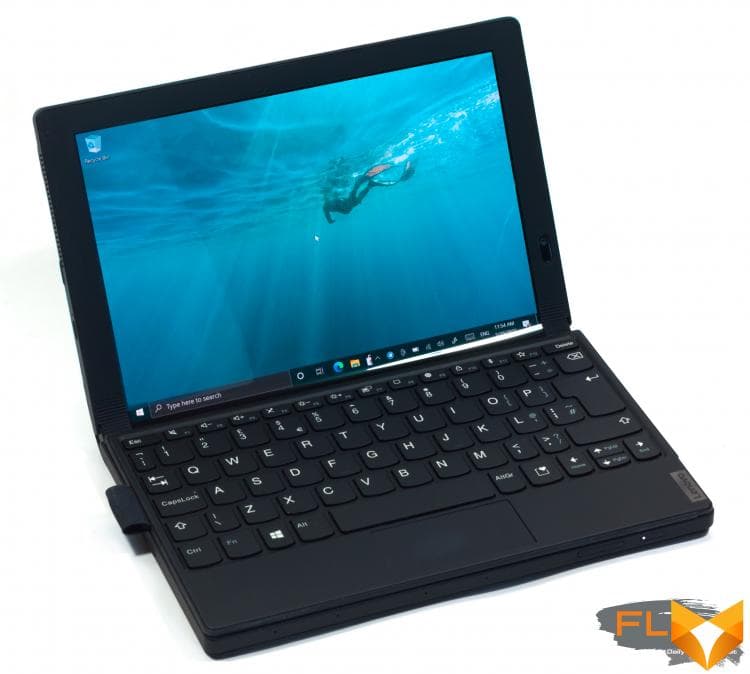
Not surprisingly, the ThinkPad X1 Fold has all the typical overhead of a long-forgotten netbook, starting with the keyboard. Its layout is different from the standard and makes you get used to keyboard shortcuts to enter less frequently used characters. And the keys, to be honest, are small and sit closely. However, Lenovo’s rich experience in designing successful keyboards has not been in vain. The ThinkPad X1 Fold’s key mechanisms have an unexpectedly pleasant tactile response, and because the panel rests on a rigid base, it flexes only slightly during typing. Allowing for key size and compromise layout, many (if not most) regular ultrabooks have worse keyboards.
What, however, can not be said about the touchpad. At first glance, it is good for its size: the panel is glass and is pressed with a confident quiet click, but using it regularly is sheer flour. Firstly, the touchpad is simply very small, and secondly, it is configured in such a way that it is extremely difficult to perform precise movements, and the cursor stalling while pressing is a common occurrence. By God, it’s better to use a complete pen instead of a touchpad. The ThinkPad X1 Fold screen is not only the first panel of its kind in a 2-in-1 device, but also the first flexible screen to support an active stylus. The digitizer recognizes 4,096 degrees of pressure, and drawing or writing by hand on a soft, grippy surface is more convenient than on glass. If only the film didn’t rub off over time, but that’s for the (no doubt few) ThinkPad X1 Fold buyers to figure out on their own. Once the stylus is active, it will have to be periodically charged via the USB Type-C connector, which is hidden under the cap at the blunt end, and here is another flaw: the cap can only be returned to its place in one position due to the fact that it is held by clips of different lengths. It turns out that the power connector is symmetrical, but its cover is not.
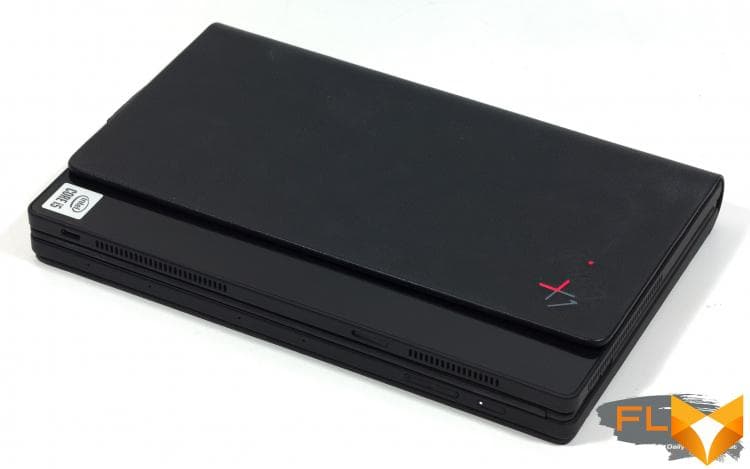
Controls are far from the only trade-off on the ThinkPad X1 Fold. The main inconvenience is related to the location of the external connectors. In laptop mode, one USB Type-C port looks up from the screen, and the second one looks to the left: wherever you connect the charger cable or USB flash drive, it comes out ugly. And if you put the computer on the table in tablet form, you simply can’t get to one of the connectors. But that’s not all: there are stereo speakers on the sides of the ThinkPad X1 Fold screen, but “stereo” is again only present in laptop mode, and when the tablet is unfolded and stands on a prop, the former right speaker is directed upwards, and the former left speaker is straight to the table.
There was no place for a fingerprint scanner in the ThinkPad X1 Fold, and even more so in order to integrate it into the side power button. The only means of biometric authentication is a combined IR and webcam.
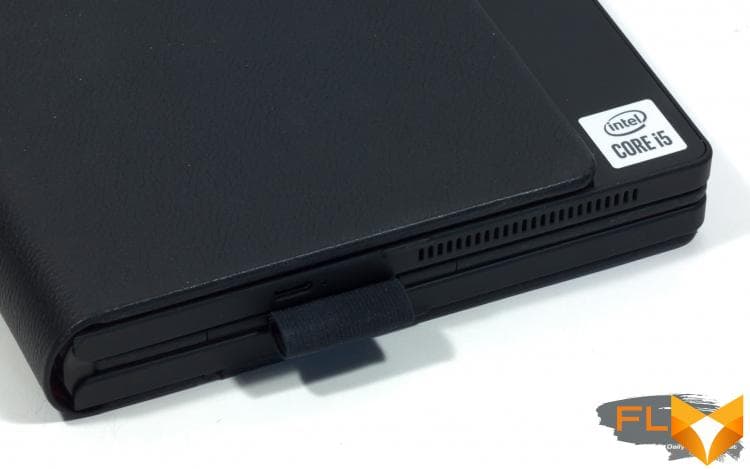
The transformer is charged via any USB Type-C connector from an unexpectedly powerful 65-watt power supply. Another reason for criticism: the charger itself is small, but along with it you will have to carry a long cable with a conventional three-lobed plug. We do not argue that an extension cable is sometimes needed, but this issue has long been resolved by a removable plug like power supplies for iPads and MacBooks, and the ThinkPad X1 Fold costs much more than almost any of them.

Finally, before we move on to performance and screen quality tests, the obvious thing must be emphasized: the ThinkPad X1 Fold is not custom upgradeable. There’s a tempting cover behind the flip-out section of the leather case that’s easy to remove, but inside the hatch we found only a few ribbon cables and nothing else. To dismantle the back panels of the case, you will have to destroy the adhesive layer on the inner surface of the case and the decorative glossy insert (it is pulled out in parts if you grab a few plastic flags with tweezers), and then you can get to the SSD. Surprisingly, it is removable (on the M.2 2242 board), but without the “native” adhesive tapes it is already impossible to return the computer to its previous appearance after disassembly.
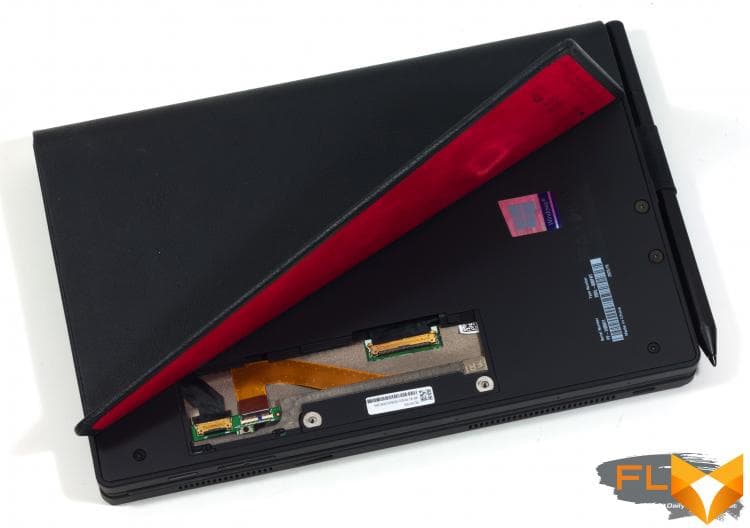
⇡#Test Methodology
| Synthetic tests | |
|---|---|
| Application | Settings |
| 3DMark Time Spy | — |
| Geekbench 4 | — |
| CINEBENCH R20 | — |
| GFXBench 5 (Aztec Ruins — Normal Tier, High Tier) | Windows: Vulkan, macOS: Metal |
| fio 3.16 | Sequential read/write, random read/write (unbuffered I/O) |
| Working Applications | |||||
|---|---|---|---|---|---|
| Application | Benchmark | Settings | API | ||
| Intel Graphics | AMD Graphics | NVIDIA Graphics | |||
| Adobe Photoshop CC 2019 | PugetBench for Photoshop CC 0.8 (linked test structure) | Basic Benchmark | OpenGL + OpenCL + Metal (macOS) | OpenGL + OpenCL + Metal (macOS) | OpenGL + OpenCL |
| Adobe Photoshop Lightroom Classic CC 2020 | PugetBench for Lightroom Classic 0.8 (test structure at link) | — | DirectX 12 (Windows) | DirectX 12 (Windows) | DirectX 12 |
| Blender 2.81a | Class Room demo from Blender Foundation | Cycles renderer. Feature Set: Supported. Tile size: 32 × 32 (CPU) or 256 × 256 (GPU) | N/A (CPU rendering) | OpenCL | CUDA/OptX |
Display testing is performed using a Datacolor Spyder4 Elite colorimeter in ArgyllCMS and DisplayCAL 3 applications.
Notebook battery life is measured at a display brightness of 200 cd/m2in the following usage scenarios:
- web surfing: alternately opening and closing tabs of Computeruniverse.ru and Unsplash.com sites with an interval of 25 seconds in the Google Chrome browser (cache and cookies are disabled);
- Continuous playback of 4K HEVC (H.265) video.
⇡#Test participants
The following devices took part in testing:
| Screen | CPU | RAM | GPU | SSD | HDD | Battery | |||
|---|---|---|---|---|---|---|---|---|---|
| Lenovo ThinkPad X1 Fold (20RL-000FRT) | 13.3”, 2048 × 1536, IPS | Intel Core i5-L16G7 | 1+4 cores/threads, 1.4-3.0GHz | LPDDR4X SDRAM, 4266 MT/s, 8 GB | Intel UHD Graphics G7 | System RAM | Toshiba BG4 (PCIe 3.0 x2) 256 GB | None | 50 Wh |
| Acer Swift 3 (SF314-57-735H) | 14”, 1920 × 1080, IPS | Intel Core i7-1065G7 | 4/8 cores/threads, 1.3-3.9 GHz | LPDDR4 SDRAM, 2666 MT/s, 16 GB | Intel Iris Plus Graphics G7 | System RAM | Intel SSD 660p (PCIe 3.0 x4) 1024 GB | None | 48.9 Wh |
| Apple MacBook Air , Early 2020 (A2179) | 13.3”, 2560 × 1600, IPS | Intel Core i5-1030NG7 | 4/8 cores/threads, 1.1-3.5GHz | LPDDR4X SDRAM, 3733 MT/s, 8 GB | Intel Iris Plus Graphics G7 | 1.5GB of system RAM | Apple AP0512N (PCIe 3.0 x4) 512 GB | None | 49.9 Wh |
| ASUS ExpertBook B9 (B9450FA) | 14”, 1920 × 1080, IPS | Intel Core i7-10510U | 4/8 cores/threads, 1.8-4.9GHz | LPDDR3 SDRAM, 2133 MT/s, 16 GB | Intel UHD Graphics 620 | ~1GB of system RAM | 2 × Samsung PM981 (PCIe 3.0 x4) 1024 GB | None | 66 Wh |
| Dell XPS 13 9300 | 13.4″, 3840 × 2400, IPS | Intel Core i7-1065G7 | 4/8 cores/threads, 1.3-3.9GHz | LPDDR4X SDRAM, 3733 MT/s, 16 GB | Intel Iris Plus Graphics G7 | System RAM | KIOXIA XG6 (PCIe 3.0 x4) 512 GB | None | 52 Wh |
| HUAWEI MateBook 13 AMD (HN-W19R) | 13″, 2160 × 1440, IPS | AMD Ryzen 5 3500U | 4/8 cores/threads, 2.1-3.7GHz | DDR4 SDRAM, 3733 MT/s, 16 GB | AMD Radeon Vega 8 | 1GB of system RAM | WD PC SN730 (PCIe 3.0 x4) 512GB | None | 41.8 Wh |
⇡#Screen Quality
The screen of the Lenovo ThinkPad X1 Fold is an OLED array, and as a result, it has an almost infinite contrast ratio. But in terms of brightness, the novelty is inferior to a number of other compact machines, and in absolute terms, this screen is rather dim.
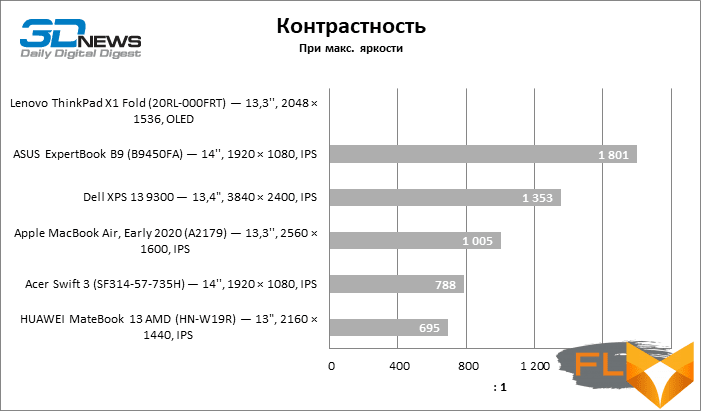
But this panel has a very wide color gamut, which, of course, causes oversaturation of shades in applications without their own color correction system. To equalize saturation when playing sRGB content, but retain the ability to work in alternative color spaces, the laptop’s proprietary software contains several color correction modes, which in theory correspond to sRGB, Adobe RGB and Display P3 standards. But, alas, none of the settings is able to adjust the coordinates of the base colors to the target values - due to the limitations of the matrix itself or inadequate profiling. The best results were offered by the Adobe RGB mode, in which the screen reached 95 percent coverage. In Display P3 mode, the panel reproduces 91% of the color range (this is exactly the case when the LEDs themselves do not have sufficient saturation in the green tint zone). Finally, in sRGB mode, the coverage is only 92%, which cannot be explained by anything other than poor CMS in Lenovo software.
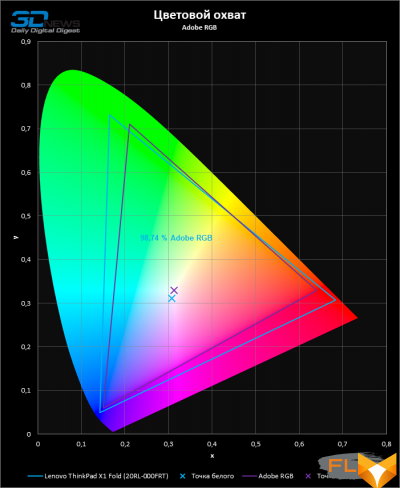
Native gamut |
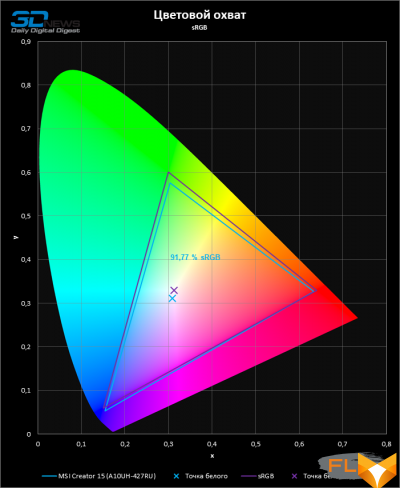
sRGB |
|
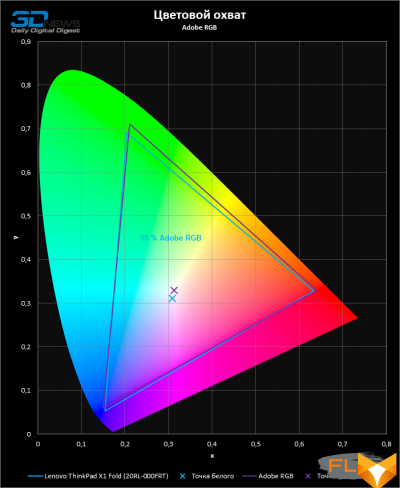
Adobe RGB |
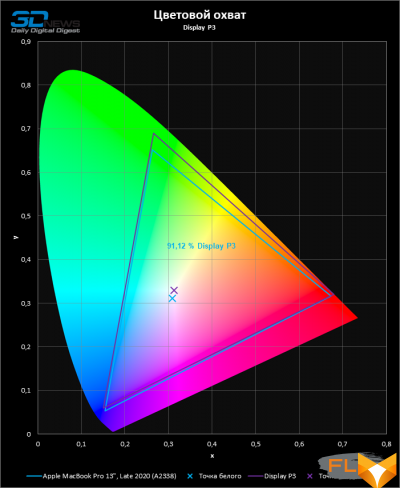
Display P3 |
On the contrary, the color temperature in any of the given color correction modes corresponds quite accurately to the reference value of 6500 K for most of the gray scale.
 sRGB |
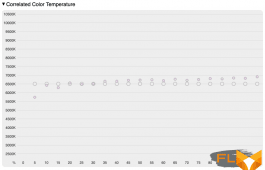 Adobe RGB |
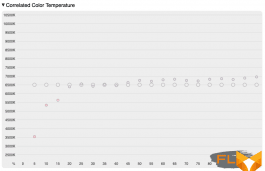 Display P3 |
But the gamma correction curves are completely different from the reference functions laid down in the Adobe RGB standards (power function 2.2), sRGB (the same, but with a linear section at the beginning) and Display P3 (similar to sRGB).
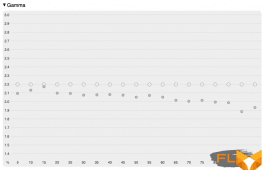 sRGB |
 Adobe RGB |
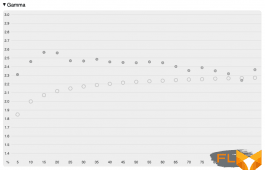 Display P3 |
All three modes are characterized by a noticeable divergence of the base colors in the dark areas of the image, shifting the latter towards the red top of the color triangle.
 sRGB |
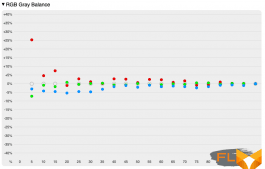 Adobe RGB |
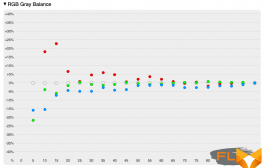 Display P3 |
Due to all these shortcomings, the laptop screen deserved mediocre color accuracy ratings. Best results are seen in Adobe RGB mode with an average Delta E of 1.84. In sRGB mode, it is 2.09, and in Display P3 mode it is 2.86 (although the latter is quite forgivable, given that the screen falls short of this standard in terms of color gamut). However, for a consumer device that is not designed for professional visualization tasks, such color errors can be considered acceptable. Our main complaints about the ThinkPad X1 Fold’s screen are still related to the mediocre margin of brightness and chaotic gamma correction curves.
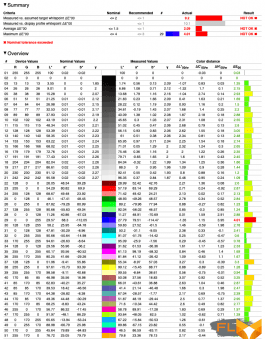 sRGB |
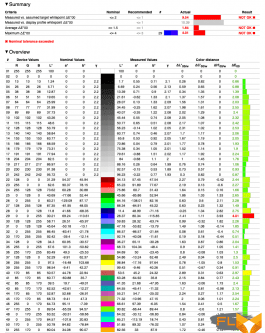 Adobe RGB |
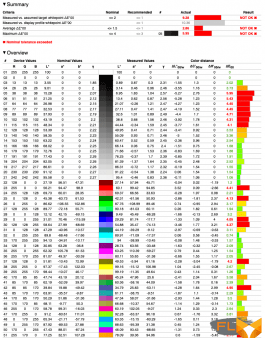 Display P3 |
⇡#Clock speeds, temperature and noise levels
The economical system-on-a-chip Intel Core i5-L16G7 is designed to operate in a 7W thermal package. Approximately such conditions are provided to her by the ThinkPad X1 Fold. For a short period of time, the power of the crystal reaches 8W, and when the x86 cores and integrated graphics are simultaneously loaded, the average power consumption drops to 5W, but in most work scenarios it stabilizes at 6W.
The specifications of the chip include high clock speeds up to 3 GHz, but in practice they are achievable only in conditions of short-term power surges, while the full load of the x86 cores leads to a drop in stable clock frequencies to the level of 1.6-1.8 GHz (high-performance the Sunny Cove core runs at a higher frequency than the weak Tremont cores). Even with a long single-threaded load, we saw an average clock speed of around 1.95 GHz on the Tremont core and 2.3 GHz on Sunny Cove.
Oddly enough, even the Intel Power Gadget utility does not allow you to monitor the clock speeds of the Core i5-L16G7 integrated graphics. It is only known that according to the specifications they do not exceed 500 MHz. However, it is noticeable that although this GPU performs only the most basic functions in the system (such as UI rendering) and is definitely not intended for work applications or games, it can draw on a large part of the SoC’s power reserve. At a time when the x86 cores are fully loaded along with the integrated video adapter, their clock speeds drop to a modest 580-755 MHz.
| Load Clock | ||||||||
|---|---|---|---|---|---|---|---|---|
| Cinebench R20 (Max Thread #) | LuxMark 3.1 | Cinebench R20 (Max Thread #) + LuxMark 3.1 | ||||||
| CPU clock speed, MHz | GPU clock speed, MHz | CPU clock speed, MHz | GPU clock speed, MHz | |||||
| Medium | Max | Medium | Max | Medium | Max | Medium | Max | |
| Lenovo ThinkPad X1 Fold (20RL-000FRT) – Intel Core i5-L16G7 / Intel UHD Graphics G7 | 1579 (Tremont)/1796 (Sunny Cove) | 1737 (Tremont)/1839 (Sunny Cove) | N/A | N/A | 755 (Tremont)/580 (Sunny Cove) | 779 (Tremont)/699 (Sunny Cove) | N/A | N/A |
| CPU and GPU power | ||||||||
|---|---|---|---|---|---|---|---|---|
| Cinebench R20 (Max Thread #) | LuxMark 3.1 | Cinebench R20 (Max Thread #) + LuxMark 3.1 | ||||||
| CPU power consumption, W | GPU power consumption (SoC as a whole, if integrated), W | CPU power consumption, W | GPU power consumption (if discrete), W | |||||
| Medium | Max | Medium | Max | Medium | Max | Medium | Max | |
| Lenovo ThinkPad X1 Fold (20RL-000FRT) — Intel Core i5-L16G7 / Intel UHD Graphics G7 | 6 | 6 | 6 | 8 | 5 | 6 | N/A | N/A |
Note The measurement is performed after the device has warmed up and all parameters have stabilized.
Despite the low power consumption, the Core i5-L16G7 die inside the ThinkPad X1 Fold gets quite hot: under load, the temperature rises to the Intel-specified limit of 100 ° C, and even when the computer is idle, it does not fall below 87 ° C.
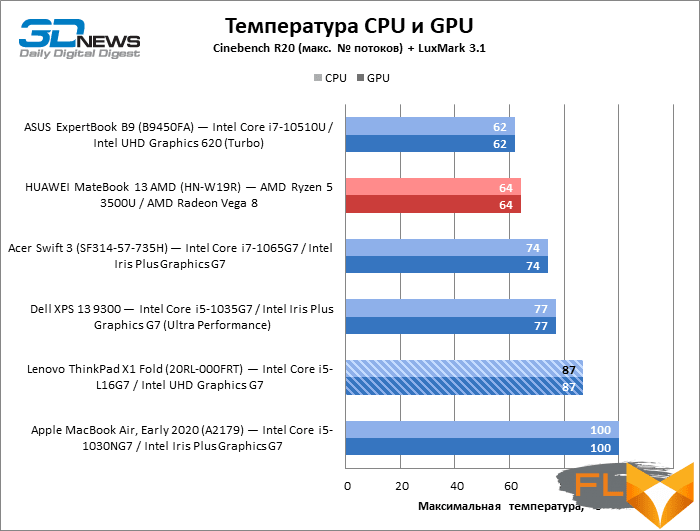
At the same time, the Lenovo transformer did not do without an active cooling system – it is an extremely quiet, but still not completely silent device.
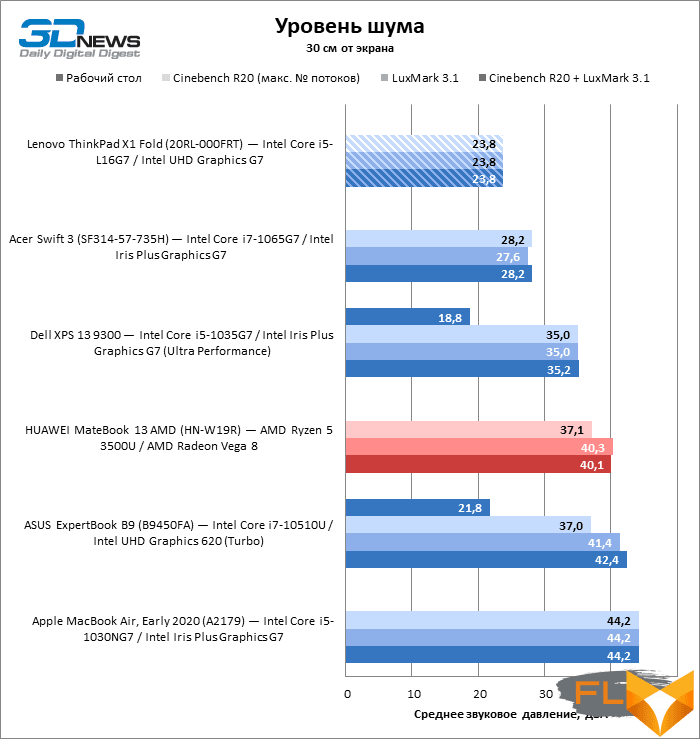
⇡#Synthetic benchmarks
A quick glance at the benchmark charts is enough to give you an impression of the performance of the ultra-efficient Core i5-L16G7 SoC. Even the smallest and lightest laptops based on conventional quad-core CPUs are several times faster than the ThinkPad X1 Fold.
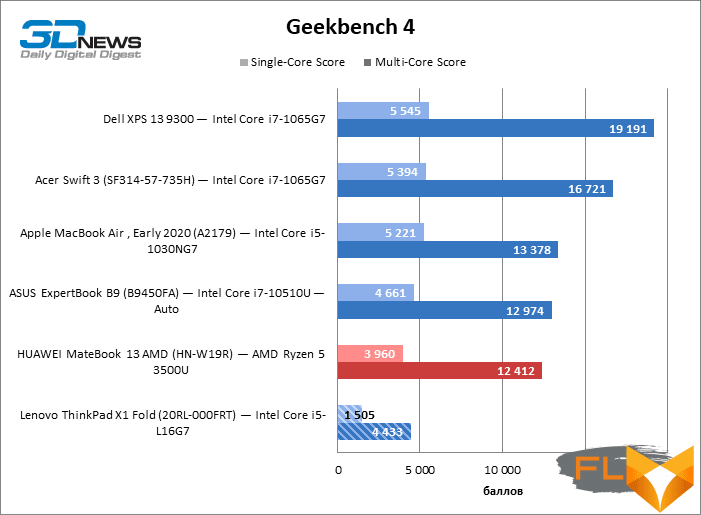
The only area of comparison where the Core i5-L16G7 scores well is in integrated graphics performance, where the ThinkPad X1 Fold sometimes outperforms Intel’s more powerful Comet Lake and Ice Lake series chips.
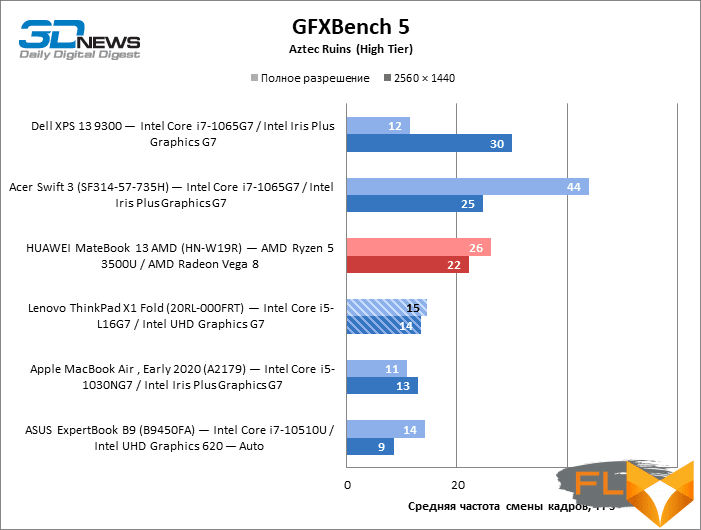
⇡#Performance in production applications
Synthetic benchmarks have already made it clear that in most cases, the ThinkPad X1 Fold does not compare to any compact laptop in terms of performance. On our own behalf, we add that the user of the novelty will feel this in the process of everyday work, even outside of resource-intensive applications: many Windows operations and the launch of built-in programs on the ThinkPad X1 Fold are accompanied by an unusual delay.
However, let’s turn again to the dry results of performance tests in order to evaluate what Lenovo had to sacrifice for the innovative design of the transformer. The first task – rendering in Blender using x86 cores – in this case can be considered a continuation of synthetic benchmarks: you need to have iron patience to do even relatively simple 3D modeling on the ThinkPad X1 Fold. The main thing is that this multi-hour test, in principle, was able to start and finish, unlike some other parts of the standard test program for work laptops.
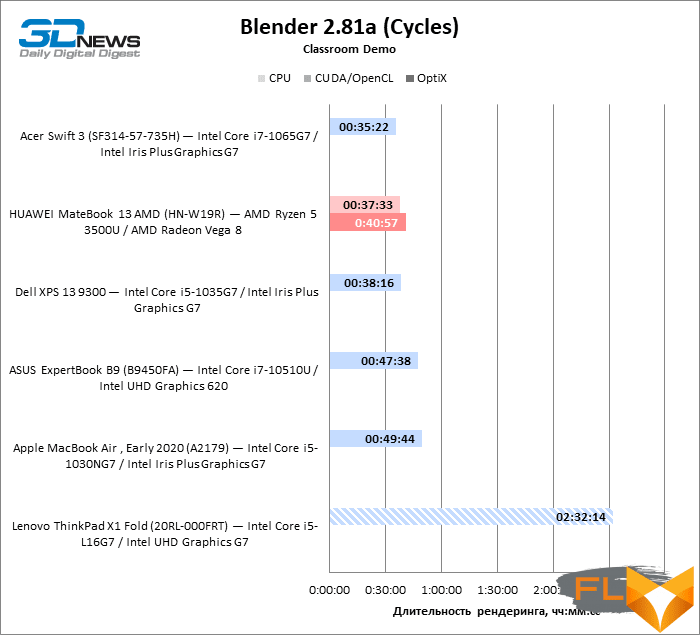
The only real-world benchmarks that the ThinkPad X1 Fold can handle are Lightroom Classic and Photoshop. These programs have long ceased to be a measure of the performance of powerful PCs, but they still have a lot to say about the capabilities of lightweight laptops. And here’s the surprise: in the Lightroom test, the Lenovo product is not inferior to the previous generation MacBook Air, but this result is most easily explained by the lack of RAM in both computers (only 8 GB).
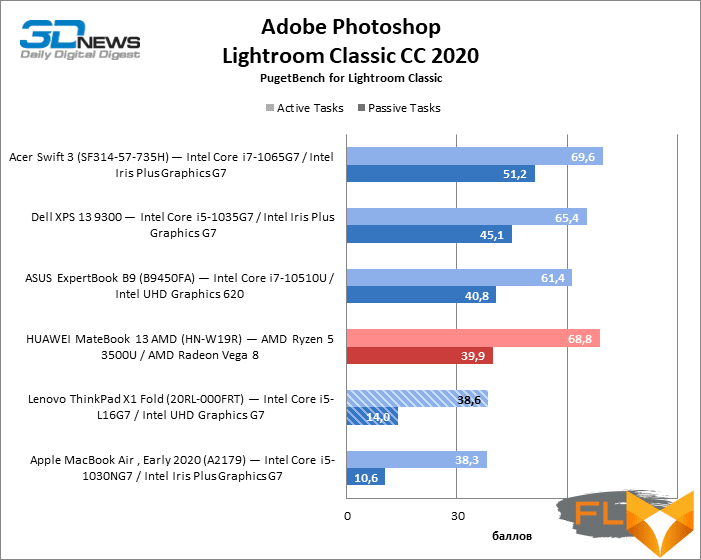
Note Scores are calculated as a percentage of Intel Reference Workstation performance Core i9-9900K, NVIDIA GeForce RTX 2080, 64GB RAM.
Well, in Photoshop, the already familiar picture was repeated: modern ultrabooks are several times superior to the ThinkPad X1 Fold in Puget Systems test suite points.
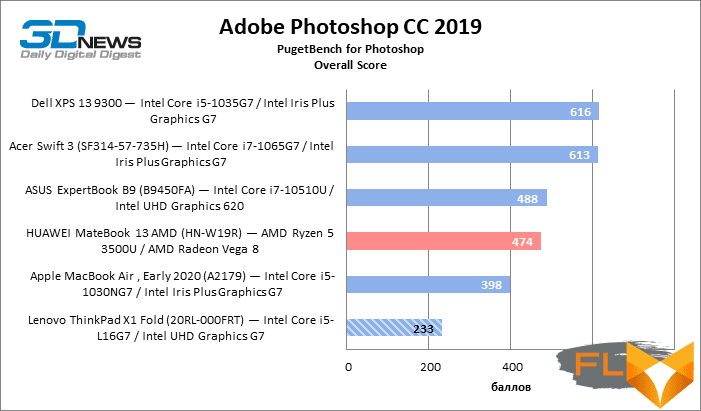
Note Scores are calculated as a percentage of Intel Reference Workstation performance Core i9-9900K, NVIDIA GeForce RTX 2080 and 64GB RAM x 10.
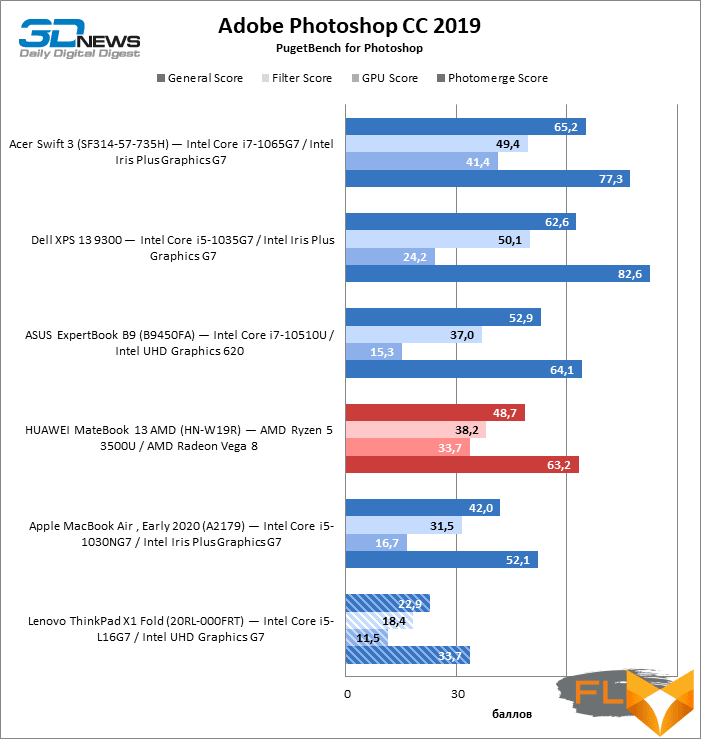
Note Scores are calculated as a percentage of Intel Reference Workstation performance Core i9-9900K, NVIDIA GeForce RTX 2080, 64GB RAM.
⇡#SSD performance
The ThinkPad X1 Fold test unit has a Toshiba BG4 SSD, which we haven’t seen in an ultrabook before. And no wonder, because this is a solution of a relatively rare M.2 2242 form factor. Unlike most other popular SSDs, this one is connected to the processor with only two, not four PCI Express 3.0 lanes and, as a result, has a rather low throughput in sequential read and write mode. But the mediocre results of random access benchmarks are also a consequence of the SSD architecture itself and to some extent the low power of the central processor, which is not able to process a large number of I / O requests.
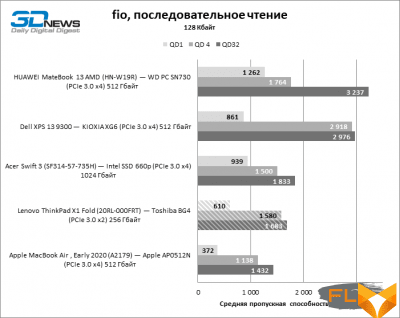 |
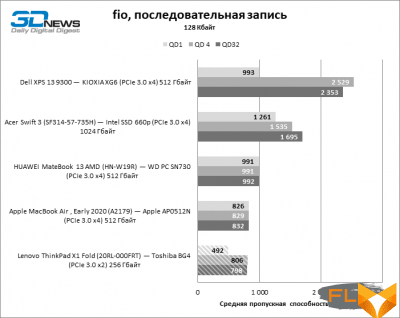 |
|
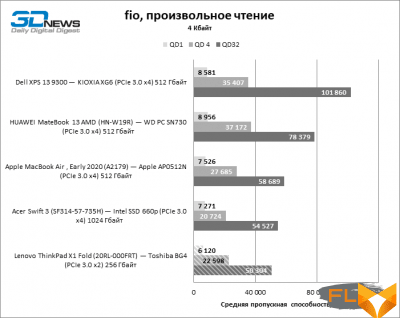 |
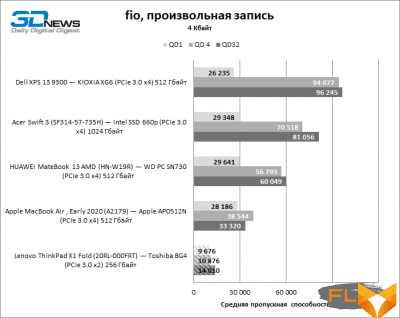 |
⇡#Battery Life
ThinkPad X1 Fold is simply obliged to work for a long time on a single battery charge, otherwise all sacrifices in performance in the name of an unusual form factor would be in vain. However, the Lenovo transformer does not complain about autonomy and withstood 7.5 hours of continuous web surfing or video playback (note, on full screen in tablet mode). Lenovo’s device is only ahead of the Acer Swift 3, which contains a battery of the same capacity but cheats in the test by gradually dimming the screen. However, we could expect better results from a computer that is all about energy saving, especially with the 50 Wh battery taking up the lion’s share of the weight and volume.
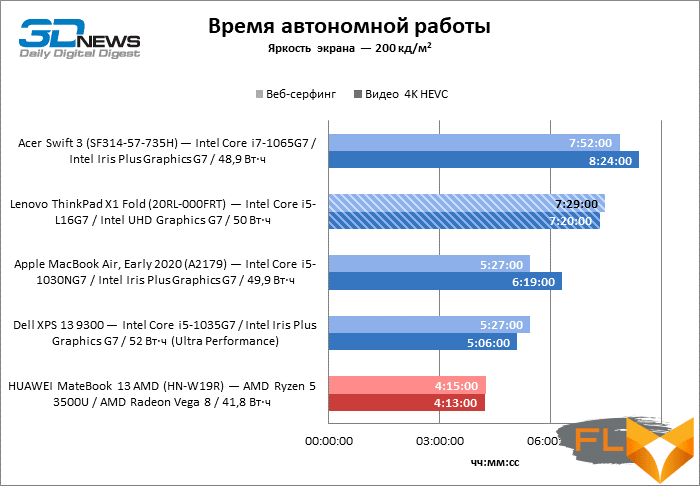
⇡#Conclusions
Lenovo ThinkPad X1 Fold is primarily a concept device that sometimes resembles a laboratory sample, and a little more. So, like many technical concepts, it has little to do with convenience and practicality. Lenovo’s idea of a flexible OLED screen certainly attracts attention. There are simply no such laptops or tablets on the market, and it’s not a fact that they will ever go to the masses. But a bold idea forced to sacrifice too much.
Let’s start with the fact that in terms of performance, the ThinkPad X1 Fold cannot be compared with almost any modern ultrabook, including the most compact or budget models, and weighs about the same with the bundled keyboard. With Lakefield chips, Intel has taken a step in the right direction, but apparently it hasn’t come a long way yet. Well, the flexible screen itself, unfortunately, does not give much to a convertible device that can work in tablet or laptop mode. As a tablet, the ThinkPad X1 Fold is by and large no better than its own kind, only running Windows, an OS still ill-suited for finger control. The stylus often saves the day, and yet it is a specialized manipulator that a modern tablet cannot rely on in any situation. And as a laptop, the ThinkPad X1 Fold is a direct reference to netbooks, with all their inherent costs in terms of wired interfaces, controls, and, again, performance. The bundled Lenovo keyboard was definitely a success (as far as it was possible in such dimensions), but the touchpad was not very good. Alas, even the battery life of the transformer is not amazing, if we take into account the battery capacity and low power consumption of the filling.
But in general, a large flexible OLED screen and Intel Lakefield SoC with a three-dimensional chip layout are cutting-edge technologies without any irony. The ThinkPad X1 Fold is expensive to manufacture and even more expensive to retail. And for more than 5900 dollars (!) You can immediately buy a good tablet, which will be lighter than the Lenovo transformer and does not require active cooling, and in all respects a more convenient laptop. The ThinkPad X1 Fold has no alternative unless you want both in one device that folds to the size of a paper diary.
